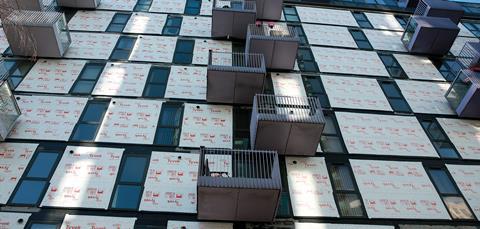- News

All the latest updates on building safety reformRegulations latest
- Focus
- Home
- News
- Focus
- Comment
- Events
- CPD
- Building the Future
- Jobs
- Data
- Subscribe
- Building Boardroom
The true cost of Gove’s new cladding policy on the housing sector
By Joey Gardiner2022-03-18T07:00:00

Source: Shutterstock
Michael Gove’s announcement that housebuilders will foot the £4bn cladding repair bill sparked a share price nosedive. Is the City overreacting?

Source: Shutterstock
Recladding work on a block of flats in a high-rise building in east London – housebuilders face an end of March deadline to finalise negotiations over liability with the housing secretary
It has been a rollercoaster couple of years for UK residential developers, with the bust and then unexpected – and prolonged – boom of the covid crisis. But we’ve reached a point where we can pretty definitively say that right now, housebuilders are not flavour of the month. Not with politicians, not with cladding campaigners – and definitely not with investors.
Because despite a recent slew of company results showing some of the sector’s top firms in positively glowing health, the share prices of the listed companies have fallen by a quarter since the start of the year. In total nearly £11bn has been wiped off the market value of the UK’s publicly traded housebuilders in a determined sell-off, to the point at which a number are now priced at less than the value of the assets they own.
This is quite something, considering Taylor Wimpey last week reported a bumper 157% boost in pre-tax profit and 54% growth in revenue in its 2021 accounts – to give one example – while Persimmon reported pre-tax profit of nearly £1bn, up 23%, on revenue of £3.6bn – to give another. Firms across the sector are reporting lengthy forward order books, huge cash reserves, and continuing strong sales demand.
…
Already registered? Login here
To continue enjoying Building.co.uk, sign up for free guest access
Existing subscriber? LOGIN
Stay at the forefront of thought leadership with news and analysis from award-winning journalists. Enjoy company features, CEO interviews, architectural reviews, technical project know-how and the latest innovations.
- Limited access to building.co.uk
- Breaking industry news as it happens
- Breaking, daily and weekly e-newsletters
Get your free guest access SIGN UP TODAY

Subscribe now for unlimited access
Subscribe to Building today and you will benefit from:
- Unlimited access to all stories including expert analysis and comment from industry leaders
- Our league tables, cost models and economics data
- Our online archive of over 10,000 articles
- Building magazine digital editions
- Building magazine print editions
- Printed/digital supplements
Subscribe now for unlimited access.
View our subscription options and join our community


















